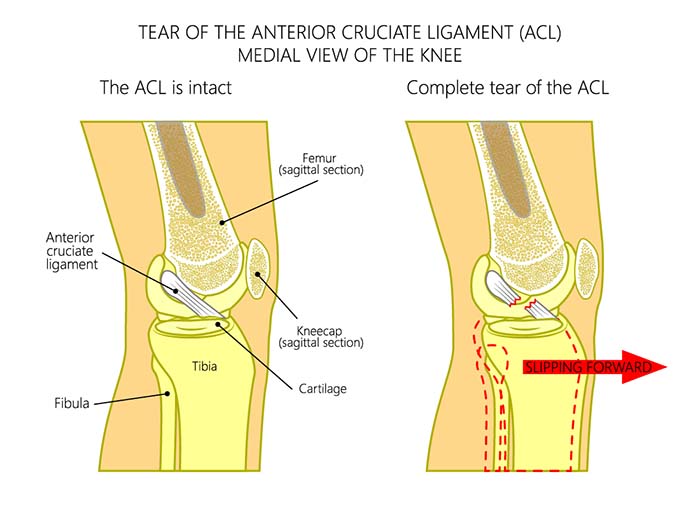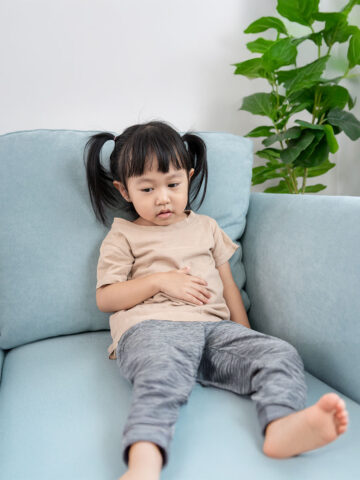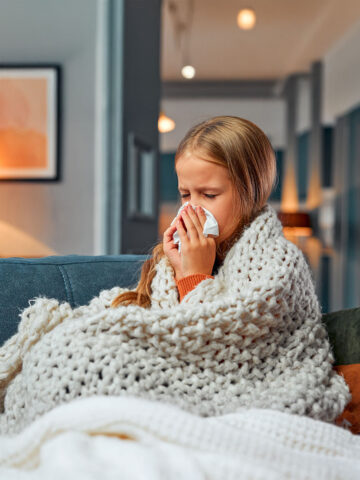An anterior cruciate ligament (ACL) tear is a common knee ligament injury that some young athletes may experience when playing high-demand sports like soccer, football, basketball and gymnastics. Oftentimes, surgery is required to treat ACL tears, leading to a six-to-nine-month recovery, causing a disruption to a child’s school and home life.
Dr. Matthew Kornswiet, a sports medicine physician and pediatrician in the CHOC Primary Care Network, urges that the best treatment for ACL tears in children or adolescents is prevention. Here, he goes in depth to what ACL injuries are, who are commonly affected and what parents can do to help.
What is an ACL?
The anterior cruciate ligament is the main stabilizing ligament in the knee. The knee joint is the junction of four bones: the femur (thighbone), tibia and fibula (shinbone) and patella (kneecap). Your kneecap sits in front of the joint to protect the rest of your knee.

The bones are connected by ligaments — or tough, flexible bands of tissue that hold bones together — and the main job of the ACL is to secure the tibia and femur together, keeping the knee stable.
What causes an ACL tear?
Most ACL tears in teens happen during high-intensity athletic activity, says Dr. Kornswiet.
Although being hit in the knee or making contact with another player can cause ACL tears, about 70 percent of tears happen without contact.
This means that oftentimes the foot will get planted in the ground when running, causing the knee to twist and bend inward. Or, an athlete may jump and land in a way that twists the knee.
What are the signs and symptoms of an ACL tear?
A tell-tale sign of an ACL tear is a “pop” feeling in a child or adolescent’s knee, followed by immediate pain. If this happens in the middle of a sports match, they should stop playing and check in with their pediatrician, sports medicine physician and/or athletic trainer before resuming activity, says Dr. Kornswiet.
Typically, the child’s knee will start to swell immediately and continue for the first several days. Afterward, a child or teen may be able to walk on their injured knee, but it will likely feel unstable or start to “give way,” causing them to stumble or fall.
Are some children at a greater risk of an ACL injury than others?
Definitely, says Dr. Kornswiet.
Any children and adolescents who play sports involving turning, pivoting and/or cutting — like soccer, football, basketball and gymnastics — may have a greater risk of sustaining an ACL injury. Especially as young athletes, both males and females may still be learning how to move their bodies correctly – they may not have good control of their body movements during sports.
In addition, female athletes are three times as likely to sustain an ACL injury as male athletes, says Dr. Kornswiet, because of the following reasons:
- The way females’ knees grow structurally during puberty, around the age of 12 to 15 years, may cause them to be more susceptible to ACL tears. Females’ joints, including the knee, generally have more flexibility and range of motion than males’.
- Because females’ hips are wider, the mechanics of how the thigh bone, tibia and femur function may change. This causes a wider angle from their knee to their hips, putting more stress on the soft tissue that supports their joints.
- Hormonal fluctuation may cause females to have periods of increased looseness in a female’s tendons and ligaments, which can make females more prone to ligament tears.
- Females tend to have stronger quadriceps than hamstrings, and males are the opposite. A strong hamstring muscle helps protect the ACL.
If you suspect that your child may have torn their ACL, when should you seek medical treatment?
If you are unsure about the nature of your child’s injury, check in with the athletic trainer at your child’s school or visit your pediatrician or sports medicine physician to receive an exam. If your child can walk on their knee following an injury, a trip to the emergency department may not be necessary.
Right after the injury, rest your child’s leg, put ice on it and make sure to elevate it. You may administer acetaminophen like Tylenol or ibuprofen like Advil or Motrin for pain as needed.
What is the treatment for a torn ACL?
Since the ACL is required for the knee to stay stable during sport activities, it is nearly always required to have it surgically replaced. The ligament itself cannot be repaired so an orthopedic surgeon will often use a tendon from somewhere else in your body to replace the torn ACL. The orthopedic surgeon will individually determine the surgical technique based on the athlete’s age and extent of the injury.
How can you prevent ACL injuries in children and teens?
Preventative programs have the biggest impact on preventing ACL tears in children and teens. Although kids can’t change their bodies’ characteristics, they can learn how to better control them, says Dr. Kornswiet.
There are programs for young athletes that teach neuromuscular control — or coordination. These programs teach repetitive movements that can help build hip and core muscles, thus creating new muscle memory that allows athletes’ legs to stay aligned when running or jumping.
Research shows that a year of consistent exercises like this, before and after practices, can have a 70 to 80 percent effective rate at preventing ACL injuries.
For young athletes that may have already recovered from an ACL injury, physical therapy and prevention programs can help prevent an ACL retear and other related injuries. Use CHOC’s exercises to help strengthen your ACL following surgery.
For more health and wellness resources from the pediatric experts at CHOC, sign up for the Kids Health newsletter.
Find a CHOC Primary Care Pediatrician
From babies to teens, pediatricians from CHOC’s Primary Care Network partner with parents to offer immunizations, sick visits, sports physicals and more.






